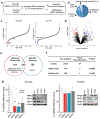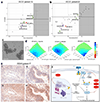Targeting BET Proteins BRD2 and BRD3 in Combination with PI3K-AKT Inhibition as a Therapeutic Strategy for Ovarian Clear Cell Carcinoma
- PMID: 33509905
- PMCID: PMC8026742
- DOI: 10.1158/1535-7163.MCT-20-0809
Targeting BET Proteins BRD2 and BRD3 in Combination with PI3K-AKT Inhibition as a Therapeutic Strategy for Ovarian Clear Cell Carcinoma
Abstract
Ovarian clear cell carcinoma (OCCC) is a rare, chemo-resistant subtype of ovarian cancer. To identify novel therapeutic targets and combination therapies for OCCC, we subjected a set of patient-derived ovarian cancer cell lines to arrayed high-throughput siRNA and drug screening. The results indicated OCCC cells are vulnerable to knockdown of epigenetic gene targets such as bromodomain and extra-terminal domain (BET) proteins BRD2 and BRD3. Subsequent RNA interference assays, as well as BET inhibitor treatments, validated these BET proteins as potential therapeutic targets. Because development of resistance to single targeted agents is common, we next performed sensitizer drug screens to identify potential combination therapies with the BET inhibitor CPI0610. Several PI3K or AKT inhibitors were among the top drug combinations identified and subsequent work showed CPI0610 synergized with alpelisib or MK2206 by inducing p53-independent apoptosis. We further verified synergy between CPI0610 and PI3K-AKT pathway inhibitors alpelisib, MK2206, or ipatasertib in tumor organoids obtained directly from patients with OCCC. These findings indicate further preclinical evaluation of BET inhibitors, alone or in combination with PI3K-AKT inhibitors for OCCC, is warranted.
©2021 American Association for Cancer Research.
Conflict of interest statement
Conflict of interest: CJK and CG are founders and equity holders in SEngine Precision Medicine. All other authors declare no conflicts of interest.
Figures






References
-
- Moore K, Colombo N, Scambia G, Kim BG, Oaknin A, Friedlander M, et al. Maintenance Olaparib in Patients with Newly Diagnosed Advanced Ovarian Cancer. N Engl J Med. 2018;379(26):2495–505. - PubMed
-
- Moore KN, Secord AA, Geller MA, Miller DS, Cloven N, Fleming GF, et al. Niraparib monotherapy for late-line treatment of ovarian cancer (QUADRA): a multicentre, open-label, single-arm, phase 2 trial. Lancet Oncol 2019;20(5):636–48. - PubMed
-
- Anglesio MS, Carey MS, Kobel M, Mackay H, Huntsman DG, Vancouver Ovarian Clear Cell Symposium S. Clear cell carcinoma of the ovary: a report from the first Ovarian Clear Cell Symposium, June 24th, 2010. Gynecol Oncol. 2011;121(2):407–15. - PubMed
Publication types
MeSH terms
Substances
Grants and funding
LinkOut - more resources
Full Text Sources
Other Literature Sources
Medical
Research Materials
Miscellaneous

